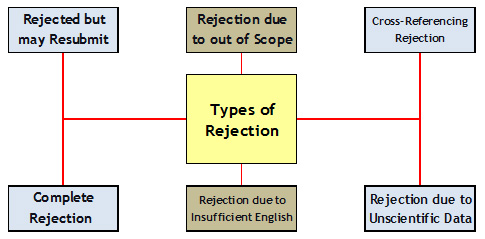Publication of Article is crucial for Career Purposes, Self-Satisfaction and Reputation Purpose. Rejection of a paper is depressing, but you have a choice after that. You may either burn or frame the rejection notice as an encouragement to start preparing to re-submit your article.

Types of Rejection
- Rejected but may resubmit – The reviewers suggested major changes that would necessitate a complete rewrite of the article in its current form. You can resubmit it. It will then be reviewed as a brand new object.
- Rejection due to out of scope – Your article will be turned down if the content of your paper does not suit the journal‘s reach.
- Cross-referencing Rejection – Your paper will be disqualified due to Plagiarism.
- Rejection due to Unscientific Data – Your manuscript will be evaluated and disqualified due to quality and presentation.
- Rejection due to insufficient English – Your manuscript will be rejected if the language is not understandable.
- Complete Rejection – Your article will be rejected if it does not have a high quality and scientific significance.
General things to be noted while publishing Journal
- Journal Article should be written based on these – Aim, Audience, Awareness of Existing work and Articulating the Ideas.
- Have a mission in writing the Journal. This will make you focus on the Scope of the Journal.
- Follow the Guidelines mainly regarding length and format. Follow the Style of the manual. Check for Grammatical Construction Typos and correct them.
- Avoid Plagiarism. Cite your Sources.
How to avoid Journal Rejection due to Content?
- Review the Abstract very closely. The Abstract should be Flawless.
- Familiarize yourself with the Journal Publication issue.
- Include Recent and Relevant, Key Publication of the Journal in Literature Review.
- Avoid Paper Focus is not directly related to the Journal Most importantly, the Paper should match the scope of the Journal.
- If you are writing for a Journal level, you are directing your Paper to Experts. So make it brief and Use a top-down approach for writing the Paper. Be focused to the point, directly begin with the aim & contribution of your work. Mention the Findings, Correlation about the topic.
- Give a Novelty Claim. Mention the novel works in your Introduction and Abstract.
- Abstract and Introduction are to be written at the end of the Manuscript.
- Make sure the Introduction should be exciting. The introduction needs to trigger the Reader and show them this is high-quality work. Cover different aspects related to the topic from the Problem to the Objective and aims to the significant importance added value, the methodology, and the results.
- Give a thought-provoking title.
- It could be the most important content to encourage reviewers to read further and potentially accept the paper.
- Highlight the added value in the Significance of your Research in the discussion or conclusion.
- Discuss Study Finding and Strengths, Study Implication and Implementation in the Future Work.
- Read the final Manuscript several times before Submitting it. This helps to get clarity and language
- Listen to the Suggestions to be made in your Paper.
Conclusion
Paper Rejection is a very common thing. Even experts have gone through Rejection. Follow the above ways to avoid Journal Rejection. Submitting the Manuscript is crucial and also you will be responsible for what you publish. So, Make a difference in Writing a Journal.


